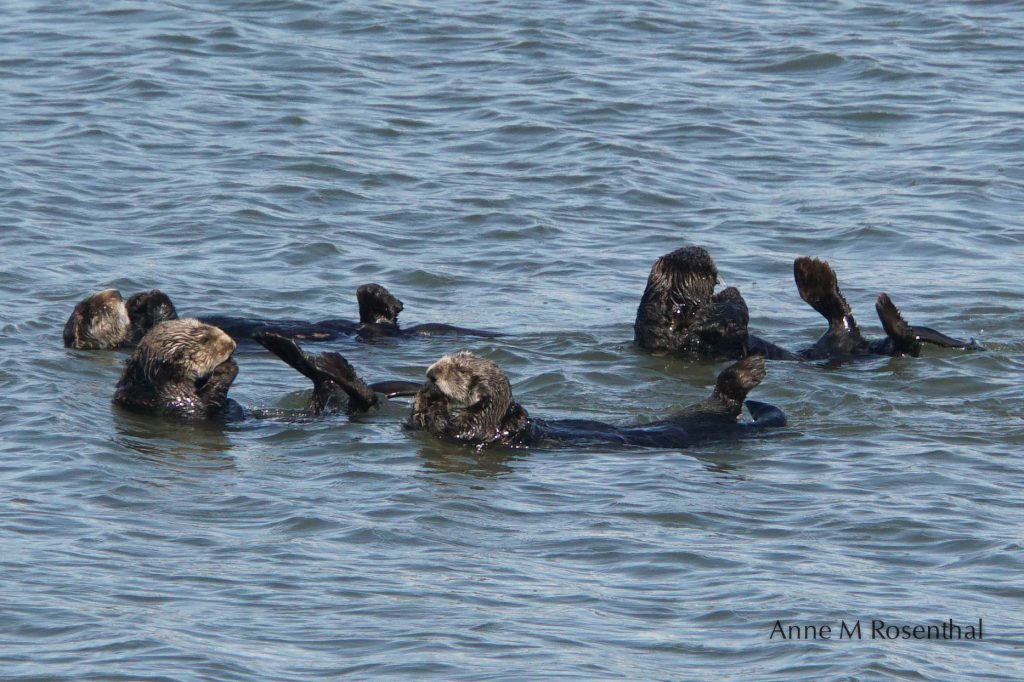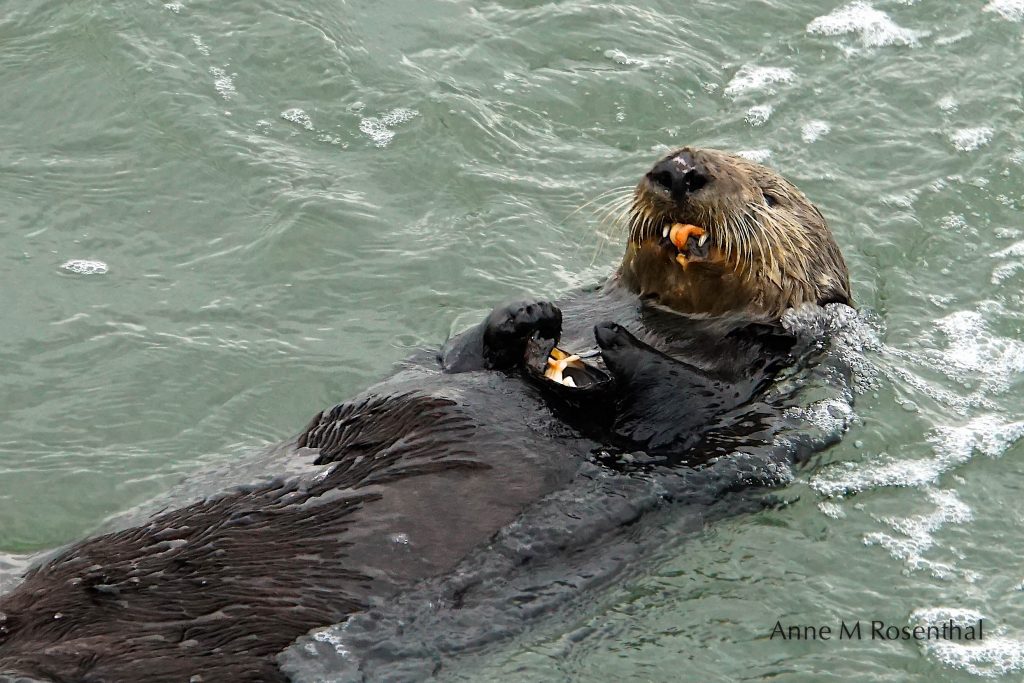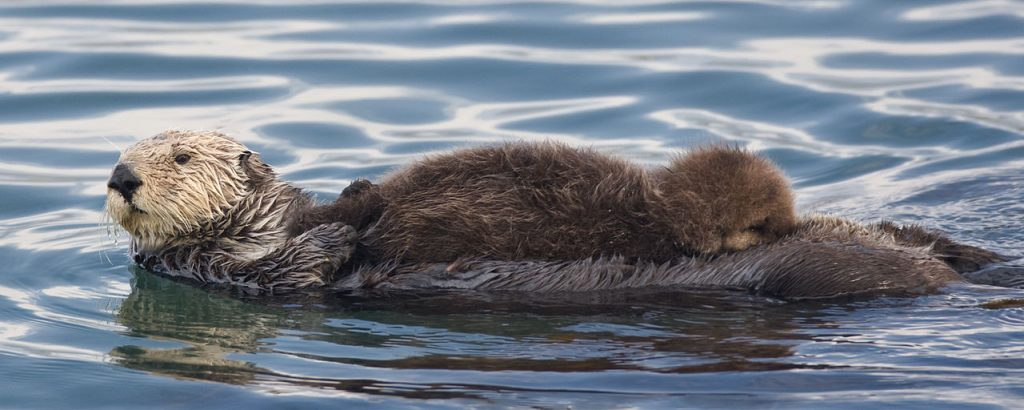
By Jeremy Geist
One of the most iconic images of ocean life is a sea otter floating on its back, with a rock on its chest and a clam in its paws. Indeed, the sea otter’s fluffy fur and cute behavior have made it one of the most popular marine animals. But the sea otter isn’t just cute – it’s a mammal highly adapted to living in the ocean, possessing a wide diet, complex social life, and optimistic conservation status.
Sea otters can be divided into three subspecies, according to Shawn E. Larson and James L. Bodkin’s article The Conservation of Sea Otters: A Prelude, published in the 2015 book Sea Otter Conservation: Russian, Northern (also called Alaskan), and Southern (also called Californian). This post will focus on the Southern subspecies, which lives along the Central California coast. Otters primarily dwell close to the coastline because, as the article also mentions, their limited diving and breath-holding abilities, compared to other marine mammals, restricts them to foraging in shallower areas.
The Otter Buffet

Sea otters eat a wide variety of food: Over 160 items may contribute to their diet, according to Stefani Paine and Jeff Foott’s 1995 book The World of the Sea Otter. Otters won’t eat everything available to them, notes Marianne Riedman in her informative 1997 book Sea Otters; what an individual sea otter chooses to eat, exactly, depends on a number of factors. In kelp forests, otters’ diets may include snails, crabs, and particularly sea urchins, which they gather from kelp fronds – often eating so many urchins it stains their bones purple.
In areas with sandy or muddy bottoms, otters often dig for clams in the seabed, mentions Riedman. She adds that when colonizing new areas, otters first eat rich, high-calorie prey like abalone, crabs, and large red urchins; once this prey is depleted, they focus on smaller shellfish. Otters store collected prey in pouches under their forelegs, which, Riedman notes, have enough space for a few urchins at a time. To human observers, an otter pulling food from these pouches may produce the illusion that it’s acquiring prey out of thin air.
An individual sea otter usually specializes in a few food items, despite the variety of prey available, according to Riedman as well as Larson and Bodkin. These specializations are frequently passed on from mother to pup, and young otters tend to eat food in the same way their mothers did. Both books speculate that this specialization helps reduce competition over food; if each otter is following a different diet, they won’t compete for prey as often.
Riedman also discusses the otters’ fascinating habit of tool use, something rare among nonhuman animals. Most commonly, otters use large rocks, both to dislodge shellfish and to break them open after surfacing. While floating on its back, an otter places the rock on its stomach and smashes a shellfish against the rock until the otter can extract the meat. Some otters also make use of other tools, including carrying discarded glass bottles to pry loose rock oysters. Like diet choices, tool use behavior is usually passed down from mother to pup.
Rafting and Playing
Otters hunt and feed solo, but rest and play are often highly social, according to Riedman and also Larson and Bodkin. They may sleep in social groups called “rafts”; in California, rafts generally range from 2 to 12 members, though groups of up to 50 have been spotted. Rafts are generally composed of the same sex, with exceptions for territorial males and newly weaned juveniles, which can be found in female groups. Larson and Bodkin note that areas where males and females congregate may remain in the same places for decades, given a consistent food supply, which speaks to the stability of these social groups. Groups of younger otters frequently play and wrestle with each other.

Mothers and Pups
While sea otters give birth year-round, Paine and Foott note that each region has its own peak pupping times. In California, sea otters most often give birth in winter or early spring. Mother sea otters can only take care of one pup at a time due to its constant grooming and feeding requirements, Paine and Foott elaborate; the dependency period of Southern otter pups, according to Riedman, is usually four to nine months.
Unlike river otters, which have safe dens in which young can hide, sea otter pups are reliant on their mother’s body until they’re capable of surviving in the frigid ocean, writes Paine. This development is accelerated by a mother sea otter’s rich milk, which Riedman describes as containing five to six times the amount of fat and protein present in cow and human milk. Infant sea otters are also covered in “natal pelage,” a fluffy fur that Riedman notes prevents them from sinking.
Learning how to survive as a sea otter takes time. The same natal pelage that keeps them afloat, notes Riedman, also prevents them from diving, so they don’t start hunting along with their mother until about four months of age, when they grow adult fur. Young otters also have to learn to differentiate what’s edible from what isn’t; Riedman describes instances of pups capturing random objects ranging from rocks to discarded shoes. The ability to use rocks to open shelled prey doesn’t become a reliable skill until about six months of age.
Parents and children split apart after about eight months, writes Paine: The occasion is marked by the youngster traveling a distance away from its mother, though Riedman notes that the mother will be the one who leaves as part of the weaning process. This parting, notably, isn’t always forever: Riedman writes about several occasions when younger, but weaned, otters returned to their mothers, begging for food and acting very much like they did as pups during the reunion.
Near Extinction and Partial Recovery
The reappearance of sea otters along California’s coast can be considered a success story for environmental conservation. Once reduced to a hidden group of 50 otters discovered off Big Sur in 1915, the Southern sea otter population recovered to over 3000 individuals as of September 2016, as reported by Paul Rogers in the San Jose Mercury News.
The historic range of Southern sea otters once extended all along the western coast of the continental United States and Baja California, as described by Riedman. But their thick fur, developed to maintain body heat in the cold of the ocean, made it appealing to industrial trappers; their proximity to the coast made them easy targets. Fur traders hunted the otters to near-extinction in the 18thand 19thcenturies, and only a portion of the southern sea otter population has recovered.
The otters’ gradual recovery is due to several factors, each of which Larson and Bodkin briefly discuss: The collapse of the fur industry, stricter wildlife laws, and the successful relocation of otters to other locations in their former territory. Developing the technology to successfully translocate sea otters took decades, as Paine discusses, but modern scientists have the ability to transport otters long distances without causing them harm.
In 1997, at the time of Riedman’s writing, the range of the southern sea otter extended from Pigeon Point near Año Nuevo State Park south to Pismo Beach. The California population was generally divided into female and male areas: Females lived mainly from Monterey to southern Morro Bay, capped on both ends by male groups at Año Nuevo and Pismo Beach.
A 2016 USGS survey of southern sea otters, conducted by Tim Tinker and Brian Hatfield in conjunction with the California Department of Fish and Wildlife, showed a sea otter population ranging from Pigeon Point south to Gaviotta State Beach, with one otter spotted near Santa Barbara.
More sea otters generally mean healthier kelp forests. Larson and Bodkin categorize sea otters as a keystone species for kelp forests – that is, one of the most important species in maintaining the health and diversity of the ecosystem in which it lives. Riedman writes that without otters’ constant predation, purple sea urchins destroy kelp forests via overgrazing, making the otter an important keystone species for kelp forests.
However, numerous challenges still face the otters in their bid for restoration. Rogers writes that range expansion both to the north and south is limited in part by increased numbers of great white sharks in those locations. Rogers also reported that sharks will bite otters fatally but do not eat them: US Fish and Wildlife conservation coordinator Lilian Carswell, who was interviewed in Rogers’ article, mentions the possibility that they are being mistaken for seals and other mammals with blubber.
In addition, recovery from a tiny remnant group poses its own problems. Larson and Bodkin raise the point that the otters’ recovery from a tiny population creates a “bottleneck” that limits genetic diversity. Lack of genetic diversity may make California sea otters less resilient to disease and environmental change.
California sea otters’ partial recovery means ample opportunity for viewing in the Monterey Bay area. Bring a pair of binoculars to one of the region’s numerous viewing spotsand see if you can find these fascinating animals.
For further reading on sea otters, you might enjoy this post on sea otter fur. Text and photos © Anne M Rosenthal.
Resources:
Monterey Bay Aquarium’s guide to the sea otter
National Geographic on sea otters
References:
Riedman, Marianne. 1997. Sea Otters. Monterey Bay Aquarium, Monterey.
Paine, Stephani, and Jeff Foott. 1995. The World of the Sea Otter. Sierra Club, San Francisco.
Larson, Shawn E., Bodkin, James L., and G.R. VanBlaricorm. 2015. Sea Otter Conservation. Academic.
Rogers, Paul. 19 September 2016. “California Sea Otter Population Reaches Record High Number.” San Jose Mercury News.
Tinker, M. Tim and Brian B. Hatfield. 2016. “California Sea Otter (Enhydra lutris nereis) Census Results, Spring 2016.” Data Series 1018. Web. Accessed November 30, 2018.
Text copyright Anne M Rosenthal.